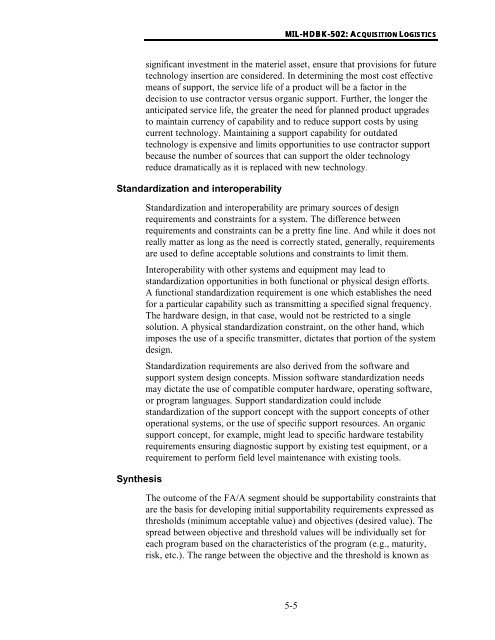MIL-HDBK-502 - Barringer and Associates, Inc.
MIL-HDBK-502 - Barringer and Associates, Inc.
MIL-HDBK-502 - Barringer and Associates, Inc.
You also want an ePaper? Increase the reach of your titles
YUMPU automatically turns print PDFs into web optimized ePapers that Google loves.
<strong>MIL</strong>-<strong>HDBK</strong>-<strong>502</strong>: ACQUISITIONALOGISTICSsignificant investment in the materiel asset, ensure that provisions for futuretechnology insertion are considered. In determining the most cost effectivemeans of support, the service life of a product will be a factor in thedecision to use contractor versus organic support. Further, the longer theanticipated service life, the greater the need for planned product upgradesto maintain currency of capability <strong>and</strong> to reduce support costs by usingcurrent technology. Maintaining a support capability for outdatedtechnology is expensive <strong>and</strong> limits opportunities to use contractor supportbecause the number of sources that can support the older technologyreduce dramatically as it is replaced with new technology.St<strong>and</strong>ardization <strong>and</strong> interoperabilitySynthesisSt<strong>and</strong>ardization <strong>and</strong> interoperability are primary sources of designrequirements <strong>and</strong> constraints for a system. The difference betweenrequirements <strong>and</strong> constraints can be a pretty fine line. And while it does notreally matter as long as the need is correctly stated, generally, requirementsare used to define acceptable solutions <strong>and</strong> constraints to limit them.Interoperability with other systems <strong>and</strong> equipment may lead tost<strong>and</strong>ardization opportunities in both functional or physical design efforts.A functional st<strong>and</strong>ardization requirement is one which establishes the needfor a particular capability such as transmitting a specified signal frequency.The hardware design, in that case, would not be restricted to a singlesolution. A physical st<strong>and</strong>ardization constraint, on the other h<strong>and</strong>, whichimposes the use of a specific transmitter, dictates that portion of the systemdesign.St<strong>and</strong>ardization requirements are also derived from the software <strong>and</strong>support system design concepts. Mission software st<strong>and</strong>ardization needsmay dictate the use of compatible computer hardware, operating software,or program languages. Support st<strong>and</strong>ardization could includest<strong>and</strong>ardization of the support concept with the support concepts of otheroperational systems, or the use of specific support resources. An organicsupport concept, for example, might lead to specific hardware testabilityrequirements ensuring diagnostic support by existing test equipment, or arequirement to perform field level maintenance with existing tools.The outcome of the FA/A segment should be supportability constraints thatare the basis for developing initial supportability requirements expressed asthresholds (minimum acceptable value) <strong>and</strong> objectives (desired value). Thespread between objective <strong>and</strong> threshold values will be individually set foreach program based on the characteristics of the program (e.g., maturity,risk, etc.). The range between the objective <strong>and</strong> the threshold is known as5-5
















